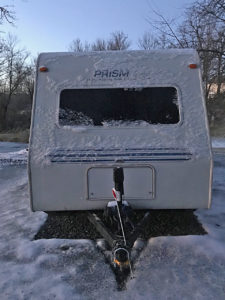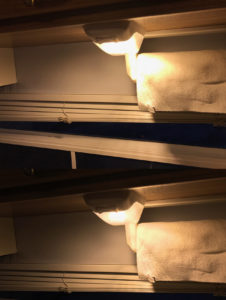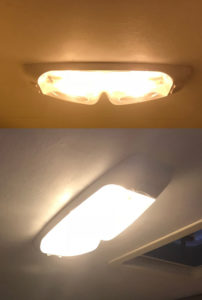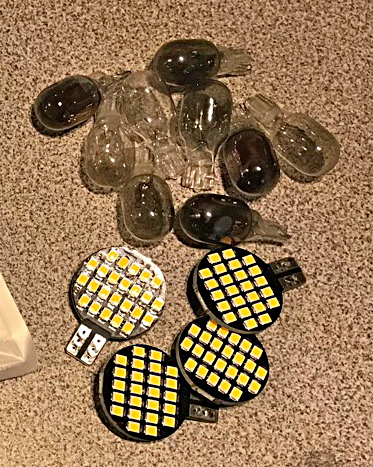
Wildheart waits in the cold winter drear for some attention, to be turned from a dull, ordinary moth into a beautiful, stunning butterfly.
As we’ve gone through the past several weeks of obnoxiously cold, snowy, wet, dreary weather, I’ve spent the majority of my leisure time either watching videos about full-time RVing, reading blogs and websites about it, or shopping for items I’ll be needing to customize my rig.
Fortunately, today is sunny and, though brisk, not too cold, so I’m feeling a reprieve. I have always been really influenced by dreary weather in a not-good way, so though I’ve never been officially diagnosed, I believe I have Seasonal Affective Disorder—SAD, what an apropos acronym! It has played a not-insignificant role in my decision to hit the road so I can become a snowbird.
As I type this, I’m going over in my head the first things I need to get done as soon as the weather warms up a bit. The first stuff is mechanical, because there’s no sense doing the interior decorating until I’m sure all my working systems are up to snuff. There’s little working area inside the camper, so when I am in there, I don’t want to have installed new paint, wallpaper or upholstery and then just mess it up right away because my dirty shoes touch it or I drop a dirty or greasy tool on them. For that reason, the cosmetic stuff will be the last upgrade to get done before I go on the road.
Incandescent vs. LED Lights
So, what I’ve done this week is upgrade the interior lighting from incandescent to LED. There were three reasons for this:
-

The difference between the sink light’s LED (top) vs. incandescent bulb (bottom) isn’t as striking as in the ceiling fixture shown below, but it’s still quite noticeable.
Power Savings – 1141 incandescent bulbs, like those you find in an overhead lamp in your car’s passenger compartment, are ubiquitous in RV interior lighting, used for overhead, wall and compartment lighting. They generally use about .57 amps of power to operate, while the replacement LED bulb panels I used require only .04 amps. In a full-time RV application, where I’ll most often be boondocking away from any kind of electrical hookups and therefore need to conserve power as much as possible, this kind of savings (about 70%) was simply a no-brainer.
- Way Better Light Quality – Standard OEM incandescent bulbs produce a measly 12 lumens of dingy, yellowish brightness,

Top: Incandescent ceiling light. Bottom: With LED replacement bulb
with an average service life of 4,000 hours. That service life seems long until you see that of their LED equivalents, and it totally makes sense when you see the weenie amount of light they generate. They are so dull, I wouldn’t even be comfortable using them as a close-up reading lamp. I can’t imagine how anyone would find them adequate as nighttime lighting, even if they aren’t full-timing!
You can see here the difference in the incandescents vs. the LEDs, which produce 400 lumens of warm (or cool, as you desire), white brightness (almost 17X the originals!), with an average service life of about 30,000 hours. This was another trade-off that required no real consideration. IMPORTANT NOTE: If you’re going to do the same kind of replacement, pay close attention to the tone of the bulbs you’re buying. If you don’t see them specifically described as something like “warm white,” you will likely end up with the cold, bluish tint that mimics fluorescents. You may prefer that, but most folks like the warmer tone unless they’re for workshop, sink or sometimes bathroom areas.
Be sure which type bulb you’re actually replacing, and get the proper ones. 1141 and 1156 bulbs look very similar, but one has a single contact on the bottom of the metal “can” that twists into the fixture receptacle, while the other has two. You can’t use one in the other’s socket.
- Ambient Heat Production – Incandescent bulbs produce quite a bit of ambient heat. Anyone who has ever attempted to change a traditional incandescent lightbulb immediately after it has blown out, without any finger protection, has learned that the hard way.
 It’s no different even with tiny T10 bulbs.
It’s no different even with tiny T10 bulbs.
In fact, if you look at the used ones I pulled out of the light fixtures, you can see that some of them got hot enough to scorch the bulb glass black, and they aren’t even burnt-out bulbs.
In a small, enclosed space such as my camper, this ambient heat can be a real problem, because it collects and can warm up the interior to an uncomfortable level, especially on summer nights. So I wanted to get rid of that issue, and LED bulb replacements, which generate no heat, were an easy and inexpensive fix. I’ve read a lot about how expensive it is to replace all trailer lights with LEDs, but that hasn’t been my experience. My rig has 10 indoor fixtures, and I was able to buy a pack of 20 LED paddle-style bulbs for less than $1.00 each. You can also get LED replacements that are closer to the traditional shaped bulbs. Again, be sure to get the temperature you like best, either warm or cool. The warmer ones have phosphors that are about the color of fresh egg yolks, while cooler ones look like glow-in-the-dark paint.
Exterior Lighting
Getting these interior bulbs switched out was a small but important step. Next up on the electrical front is replacing all the exterior bulbs and the whole porch light fixture, whose switch no longer works at all. I can see it’s already been repaired once, and the switch is really “spongy” in its action, so it’s just time for a whole new replacement. Easy fix: I already got the new fixture and the butyl tape that will form a gasket seal between it and the fiberglass side of the trailer.
But all that exterior work will need to wait until the weather warms up significantly and for a reliable period of time. It can be challenging enough working with electrical, without having to fight stiff wires that won’t bend easily because they’re too cold, fingers that won’t work easily because they, too, are cold and stiff, and knees that won’t bend because…well, you get the picture.
Up Next
So, for the time being, I’m contenting myself with shopping for a new house battery to replace the marine starting battery the previous owner used. That’s okay for “weekender” style camping but for full-timing, I will be replacing it with a proper 12V deep-cycle house battery that can be recharged by “shore power” (plugging into an outlet), generator or solar. I’ll eventually be using all three.
Products mentioned in this post
Full disclosure: I am an Amazon Associate, so part of your purchase through some of the links or portals on this website will help support this site, at no extra charge to you. Thanks for helping me to help you and others by supporting my ability to provide this valuable safety information.

Recent Comments